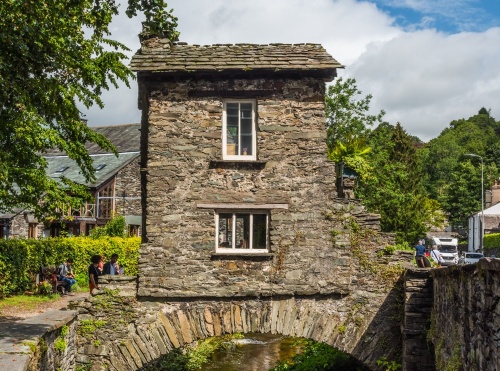
Bridge House in Ambleside is a Lake District icon and is probably the most photographed building in the National Park. The picturesque 17th-century building sits directly over Stock Beck at the northern edge of Ambleside.
By the Victorian period, it was considered a 'curious relic' and 'one which every artist sketches as he passes by'. One of those artists who paused to paint Bridge House was JMW Turner.
The house is a 'one up, one down' design, with two small rooms linked by an external stair. The roof is made of traditional Lake District slate, with small tiles at the ridge and progressively larger tiles towards the eaves.
History
We do not know exactly when Bridge House was built but we do know who built it. In the 17th century, the Braithwaite family lived at nearby Ambleside Hall. The Braithwaites needed a way to reach their property on the far side of Stock Beck.

It seems likely that the Braithwaites first built a bridge over the beck, and later added a house on top of the bridge to store apples from their nearby orchards. The humpbacked bridge may even predate the house by several centuries.
Bridge House had doors opening onto each bank so people could pass directly through the house and cross over the beck below. The rear door was later blocked and a chimney inserted but you can see traces of the original 17th-century doorway.
In the 18th century, Bridge House was used as a counting house for a pair of mills that stood nearby. Since then it was put to a variety of uses; it was, in turn, a weaver's shop, cobbler's shop, an antique shop, a chair maker's shop, and a tearoom. It was when the building became a tearoom in the Victorian period that a cast-iron stove was inserted in the rear wall where the doorway had been.

Most surprisingly it was used as a dwelling, with records showing a family of 8 living here at one time. When you see the size of the two rooms that seems almost unbelievable.
Census records show that at one time during the 19th century Bridge House was the home of John Rigg and his 6 children. Rigg was a basket weaver and maker of rush seats. The National Trust, who look after the property, present it as it might have been during Rigg's lifetime, with examples of traditional rush-seated chairs and woven baskets, along with tools used in the weaving process.
We know that the popular author Beatrix Potter, who lived at nearby Far Sawrey, visited Bridge House in the 1920s when the house was in a poor state of repair and was threatened with demolition. In 1926 a local group including Potter's husband William Heelis raised money to buy Bridge House and gave it to the recently-formed National Trust. In 1956 it became the Trust's first information centre and later served as a shop.

Visiting Bridge House
The Trust now opens Bridge House on selected days during the year. In theory, the house is open from 11.30am to 4.30pm during the spring, summer and autumn. I say 'in theory' because open days are not always well advertised and seem to be changeable depending on the availability of volunteer guides; we visited on a sunny day in July when it 'should' have been open only to find the house shut and a small sign telling us the next open day was in four days time. So we dutifully showed up 4 days later and were waiting when a National Trust volunteer opened the doors.
Be aware that Bridge House is extremely popular when it is open - in part because Ambleside is such a busy place in summer and thronged with tourists. Most of those tourists eventually pass by Bridge House and pop in for a quick look around. And it will be a quick look, for the two rooms are incredibly small.
It is astonishing to think of a family living at Bridge House. There are just two rooms, one at ground level and one above.

The ground-level room has a cast-iron range against one wall, inserted in the Victorian period. The fireplace occupies the space where the original 17th-century doorway used to be. There are a pair of rush-seat chairs and a traditional woven basket on the floor with several sets of clogs. Tucked into the wall space behind the door is a tall cupboard. There are small windows on both sides, overlooking the beck.
The curving external stair, made of stone and slate, leads to the first-floor chamber. This has two rush-seat chairs against the far wall, a traditional woven basket on the floor, and a small table on one side. The walls are lined with examples of basket weaving tools and materials, showing how basket and chair makers like John Rigg worked and the materials they used.
And that's it. Even the most dedicated visitors will not take long to explore the two rooms. But don't get the wrong impression; we loved visiting Bridge House. The building is extraordinary, and its unusual location over the beck is one that will live long in the memory.
Getting There
Bridge House is just a few steps from the main visitor car park on Rydal Road (the A591), at the northern edge of Ambleside. From the car park exit turn right onto Rydal Road and you will see Bridge House directly ahead of you. Even when the House is closed you can walk up to the front door, climb the steps to the first-floor entrance, and walk around to the far side of the beck to relax in the small garden area.
About Bridge House, Ambleside
Address: Rydal Road,
Ambleside,
Cumbria,
England, LA22 9AY
Attraction Type: Historic Building
Location: On Rydal Road (the A591) extremely close to the main visitor car park.
Website: Bridge House, Ambleside
Email: windermere@nationaltrust.org.uk
National Trust - see also:
National Trust memberships (official website link)
Location
map
OS: NY375047
Photo Credit: David Ross and Britain Express
NEARBY HISTORIC ATTRACTIONS
Heritage Rated from 1- 5 (low to exceptional) on historic interest
Stock Ghyll Force - 0.7 miles (Countryside) ![]()
Ambleside Roman Fort - 0.9 miles (Roman Site) ![]()
Stagshaw Garden - 1.2 miles (Garden) ![]()
Skelghyll Wood - 1.2 miles (Countryside) ![]()
High Sweden Bridge - 1.3 miles (Countryside) ![]()
Rydal Falls - 1.4 miles (Countryside) ![]()
Rydal Mount - 1.6 miles (Historic Building) ![]()
Rydal Water - 1.6 miles (Countryside) ![]()
Nearest Holiday Cottages to Bridge House, Ambleside:
More self catering near Bridge House, Ambleside














